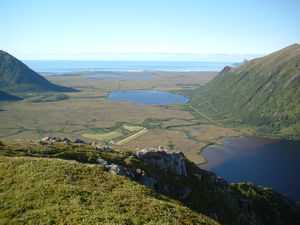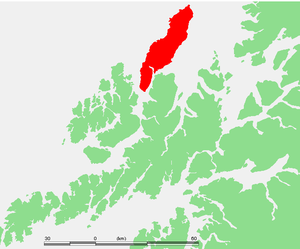Andøya
| Andøya | |
|---|---|
| Andøya, view over the Roksdal to North Mela | |
| Waters | European Arctic Ocean |
| Archipelago | Vesterålen |
| Geographical location | 69 ° 6 ' N , 15 ° 43' E |
| length | 70 km |
| width | 7 km |
| surface | 489 km² |
| Highest elevation | Kvasstinden 705 moh. |
| Residents | 3600 7.4 inhabitants / km² |
| main place | Andenes |
Andøya is the northernmost island of Vesterålen in the Norwegian Fylke Nordland and part of the Andøy municipality . The island is the tenth largest in the country, on it extends the country's largest contiguous moor area (263 km²). The wealth of cloudberries is proverbial for the island.
General
In addition to fishing and tourism ( whale watching ), peat extraction is an important industry. Peat was once the only fuel on the barren islets in the north.
Andøya is connected to Hinnøya and thus to the mainland via the Andøybru bridge on Riksvei 82. The bridge spans the Risøysund near Risøyhamn in the southeast; there also make ships of the Hurtigruten station. At the northern tip of the island is Andenes , the administrative center of the municipality .
geology
The coal deposit in Fjell Ramsåfeltet is a geological feature . Except on Svalbard, there are no other deposits in Scandinavia . These occurrences date back to 250 to 90 million years ago. The fell is also rich in fossil finds . A special example is the discovery of a 3 m long ichthyosaur from the Jura .
climate
| Andøya 1961-1990 | ||||||||||||||||||||||||||||||||||||||||||||||||
|---|---|---|---|---|---|---|---|---|---|---|---|---|---|---|---|---|---|---|---|---|---|---|---|---|---|---|---|---|---|---|---|---|---|---|---|---|---|---|---|---|---|---|---|---|---|---|---|---|
| Climate diagram | ||||||||||||||||||||||||||||||||||||||||||||||||
| ||||||||||||||||||||||||||||||||||||||||||||||||
|
Average monthly temperatures and rainfall for Andøya 1961–1990
|
||||||||||||||||||||||||||||||||||||||||||||||||||||||||||||||||||||||||||||||||||||||||||||||||||||||||||||||||||||||||
history
Andøya was populated as early as the Scandinavian Stone Age, as is shown by finds of 11,000 years old charcoal. The almost ubiquitous rock carvings on the coast suggest diverse human activities in the Younger Bronze Age .
The name Andøya comes from the Iron Age or the Viking Age . For the island, the name Omd is passed down in the sagas of the Icelandic Snorri Sturluson and King Olav I Tryggvasons .
In the village of Åse , about 40 km south of Andenes, a circular rampart from the earlier Iron Age has been excavated, as well as Engeløya and Borg , another chief seat of Hålogaland .
Refugial space during the last glacial period
During the last major glaciation phase (around 22,000 to 17,700 years ago) of the Last Ice Age , known as the Vistula Ice Age , the island region of Andøya was the only area in Scandinavia that was largely not hidden under glaciers . Andøya functioned as a refuge from which, after the Scandinavian glacier shield receded around 13,500 years ago, trees such as spruce ( Picea ) and pine ( Pinus ) could quickly settle in the regions that were freed. In particular for the recolonization of Norway by the Norway spruce ( Picea abies ) and its current biodiversity , the remnants on Andøya played a major role. The survival of the Nordic vole on Andøya during the last major glaciation phase can be assumed, but not proven.
Andøya not only served as a unique refuge in Northern Europe for land life, but also for marine such as the common cockle . Even a trans-Arctic and trans-Atlantic recolonization, with Andøya being a kind of bridgehead in Europe, was detected in the case of the macroalgae Fucus distichus .
Due to its special prehistory as a refuge, Andøya's biodiversity is remarkably pronounced.
Research stations
On the Oksebasis, a rocket launching station called Andøya Rakettskytefelt , there are research stations that study the aurora borealis and the atmosphere, and an observatory that studies the atmosphere with a particularly powerful laser beam . Thought is also being given to launching small satellites into orbit from here .
An airfield is attached to the research and military bases . The Oksebasis is 6 km southwest of Andenes, the airfield immediately south of the village.
The midnight sun can be observed from May 19 to July 25 in the main town .
Web links
- Andøya in the store norske leksikon
- Fossils from Andøya in an exhibition at the University of Oslo ( Memento from June 11, 2007 in the Internet Archive )
- Northern lights exploration in Andenes ( Memento from May 23, 2009 in the Internet Archive )
- Statistics from the municipality of Andøy ( Memento from March 19, 2007 in the Internet Archive )
- Andøy municipality
Individual evidence
- ↑ Tore O. Vorren, Karl-Dag Vorren, Torbjørn Alm, Steinar Gulliksen, Reidar Løvlie: The last deglaciation (20,000 to 11,000 BP) on Andoya, northern Norway. In: Boreas 17, No. 1, 1988, pp. 41-77, doi: 10.1111 / j.1502-3885.1988.tb00123.x .
- ↑ Laura Parducci, Tina Jørgensen, Mari Mette Tollefsrud, Ellen Elverland, Torbjørn Alm, Sonia L. Fontana, KD Bennett, James Haile, Irina Matetovici,, Yoshihisa Suyama, Mary E. Edwards, Kenneth Andersen, Morten Rasmussen, Sanne Boessenkool, Eric Coissac, Christian Brochmann, Pierre Taberlet, Michael Houmark-Nielsen, Nicolaj Krog Larsen, Ludovic Orlando, M. Thomas P. Gilbert, Kurt H. Kjær, Inger Greve Alsos, Eske Willerslev: Glacial survival of boreal trees in Northern Scandinavia. In: Science 335, No. 6072, March 2, 2012, pp. 1083-1086 ( PDF ).
- ↑ Anne van Woerkom: Cryptic Refugia vs. Tabula Rasa: Boreal Trees in Glacial Fennoscandia: Plant Growth during the Weichselian Glaciation and the Early Holocene in Northern Europe . Umeå Universitet 2016 ( PDF ).
- ↑ Per Arild Aarrestad, Tor Myking, Odd Egil Stabbetorp, Mari Mette Tollefsrud: Foreign Norway spruce (Picea abies) provenances in Norway and effects on biodiversity. In: NINA Report 1075 (Norwegian Institute for Nature Research), Trondheim, October 2014, ISBN 978-82-426-2694-3 ( PDF )
- ↑ Cecilia Brunhoff, Nigel G. Yoccoz, Maarit Jaarola: Glacial survival or late glacial colonization? Phylogeography of the root vole (Microtus oeconomus) in north-west Norway. In: Journal of Biogeography , 2006, doi: 10.1111 / j.1365-2699.2006.01573.x .
- ↑ Evgeny Genelt-Yanovskiy, Sophia Nazarova, Oleg Tarasov, Natalia Mikhailova, Petr Strelkov: Phylogeography of the temperate marine bivalve Cerastoderma edule (Linnaeus, 1758) (Bivalvia: Cardiidae) in the Subarctic: Unique diversity and strong population structuring at different spatial scales . In: Journal of Zoological Systematics and Evolutionary Research 57, No. 1, 2019, pp. 67-79, doi: 10.1111 / jzs.12231 .
- ↑ James A. Coyer, et al. Trans ‐ Pacific and trans ‐ Arctic pathways of the intertidal macroalga Fucus distichus L. reveal multiple glacial refugia and colonizations from the North Pacific to the North Atlantic. In: Journal of Biogeography 38, No. 4, 2011, pp. 756-771.
- ↑ Michael T. Burrows: Arctic nearshore biodiversity research: The UK and Scottish view. In: New Census of Marine Life Initiative 2003, p. 113 ( PDF ).
- ↑ Kjetil Bevanger: Biodiversity in Norway. In: Global Biodiversity Volume 2: Selected Countries in Europe, 2018, p. 223.




